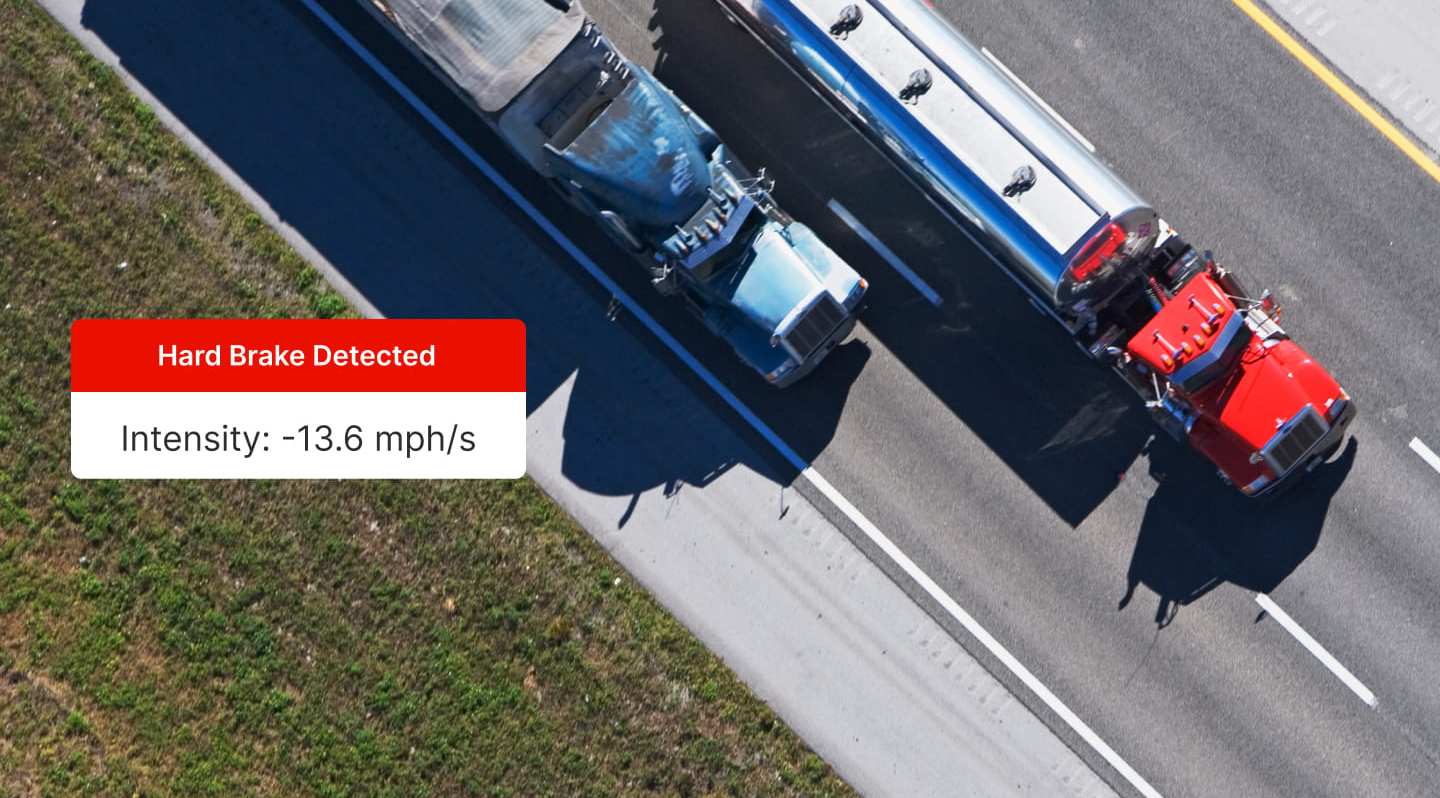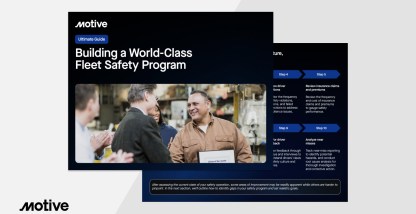Transportation and logistics companies are under constant pressure to meet supply chain demands, comply with regulations, and optimize their operations. Yet fleet owners share another common goal: getting road drivers home safely at the end of the day. Anti-lock brakes help fleet managers reach that goal by supporting fleet vehicle safety. Learn the basics, benefits, and anti-lock brake best practices in this article.
What is ABS and what does ABS stand for?
ABS is a common abbreviation of anti-lock brake systems. An anti-lock braking system is a safety feature because it helps drivers remain in control of their vehicles during hard braking.
Anti-lock brake technology was first seen in cars in the 1920s. But it wasn’t until the 1990s that they grew common in trucks and cars. The United States and Canada have required ABS on medium and heavy trucks, tractors, semi-trailers and buses since 2000. Since 2012, ABS has been standard in all new passenger vehicles manufactured in both countries.
Why are anti-lock brakes better?
In an emergency, you may have to brake suddenly and forcefully. But this could cause skidding, and drivers can lose control of their vehicles. An ABS restores the grip to tires while maneuvering the wheels. Drivers no longer need to think — in the moment — of “pumping the brakes” or worry about how to steer the wheels properly; ABS technology keeps the wheels from locking during hard braking. This is especially useful on slippery roads or gravel surfaces on which it can be more difficult to control steering when braking with force.
How anti-lock brakes work
An ABS consists of a hydraulic unit, electronic control unit, and speed sensors. Wheel-speed sensors transmit information to the control. When the control unit determines pressure is applied to the brakes, it controls the hydraulic unit’s force. If the wheels are at risk of locking, the system releases just enough to keep the wheel moving while still applying brake force.
In fact, ABS can apply differing amounts of force to different wheels, or may release repeatedly in just a second to help avoid skidding, jackknifing, and trailer swing-out. The hydraulic pressure might pump as rapidly as 15 times a second.
In a conventional skid, loss of control of vehicle steering can result in the vehicle continuing to travel in the direction of the skid. With ABS, however, the modulation of the brakes improves your control of the vehicle to better enable you steer out of the skid.
Drivers can let the ABS do what it is designed to do by avoiding pumping the brake pedal in abrupt stops. Instead, drivers apply a solid, steady pressure to the brakes until the vehicle comes to a stop. With ABS, pumping the brakes will only make it take longer for the vehicle to stop.
What are the three types of ABS?
There are three main kinds of ABS. These types of anti-lock brake system are differentiated by the number of sensors (or channels):
- Four-channel/four-sensor ABS has the capability to pulse only the affected wheel or wheels
- Three-channel/three-sensor ABS features two front ABS sensors and one in the rear, located in the axle housing, to affect both rear brakes
- One-channel/one-sensor ABS is common in trucks with rear anti-lock brakes. The sensor is only in the rear axle housing.
The four-channel ABS is generally considered the best as it monitors and controls each wheel independently. With a three-channel system controlling both rear wheels it is possible one wheel could still lock.
Importance of anti-lock brakes in fleet vehicles
Fleet vehicles are often on the road heavy with loads. They are also bigger and more unwieldy than passenger cars. This means they require a larger space cushion as it can take longer to come to a full stop, even in good conditions.
ABS technology is particularly important. Anti-braking technology makes it easier to steer safely and remain in control, which is all the more important when the vehicle in question can weigh as much as 80,000 pounds. Under ideal conditions, a car might take five seconds to stop from 60 mph (96.6 kph). But, if a wheel locks, it can stop spinning in under a second. That leads to the car skidding. The effect is magnified in larger, heavier vehicles. With an ABS in control, the tires can slow at the same rate as the vehicle.
Fleet vehicles with multiple-drivers
ABS is particularly important for fleet vehicles that have multiple drivers as the individual behind the wheel can’t rely on familiarity with that particular vehicle. Unlike when a driver has day-in day-out experience with the same brakes, and gets used to that vehicle’s responsiveness, fleet drivers can benefit from the improved responsiveness offered by ABS.
Anti-lock brakes and fleet safety
Interest in vehicle safety features and government mandates are driving ABS market growth globally. Today, anti-lock braking system manufacturers offer ABS for vehicles with two wheels, passenger cars, and commercial vehicles. This section covers some of the central benefits of ABS.
Reduce risk of accidents and injuries
The effect of ABS on crash rates continues to be an area of study. One National Highway Traffic Safety Administration (NHTSA) report noted “under many pavement conditions antilock brake systems allow the driver to stop a vehicle more rapidly while maintaining steering control even during situations of extreme, panic braking.” The same report cited other research:
- Crediting the introduction of ABS with a 24 percent reduction in multi-vehicle crashes involving fatalities, and nonfatal crashes by 14 percent
- Associating ABS with a 17 percent decrease in rollover crashes, a 13 percent reduction in frontal impacts with parked vehicles or fixed objects, and a reduction in pedestrian crashes on dry roads and in unfavorable conditions of 30 percent and 10 percent respectively
Decrease fleet liability
You can’t predict what will happen on the road, but with anti-lock brake systems cutting accident rates and related injuries, you can anticipate a decrease in fleet liability. This not only helps protect your business’ bottom line but also avoids potential damage to your company’s public image.
Better bottom line
Keeping your vehicles well-maintained and safe on the road means fewer disruptions. This can increase your operational efficacy. When your vehicles perform better, your fleet delivers loads on schedule and keeps customers happy, which can lead to more contracts and business growth.
Drivers will enjoy the consistent workload and feeling safe in their vehicles while driving for your fleet. This boosts your retention rates, which in turn, NTSCE research shows, can help lower your collision rates too.
Anti-lock brakes best practices for fleets
You want your fleet vehicles out on the road. Still, it’s important to take the time to ensure vehicle safety. You don’t want your drivers to be out on the road when they realize there is a problem with the ABS on their vehicle. These best practices can help make fleet vehicle safety easier.
Check vehicle before driving
As part of your vehicle inspection routine, you’ll want to confirm before going on the road that the ABS is functioning properly. That starts with knowing where to find the ABS lamps. Typically, you can find a yellow colored lamp, marked “ABS,” on the truck or bus instrument panel. ABS controls are designed to warn the driver of any malfunction. Issues may arise when sensors are affected by debris or metal shavings or the unit wiring is damaged. Brake system neglect or contaminated brake fluid can also cause ABS problems.
Coach driver behavior
Comprehensive driver training is a key safety improvement strategy. Anti-lock brakes are a helpful tool, but they will have a greater success rate when you coach your drivers to avoid risky behaviors. This includes:
- Speeding
- Aggressive driving
- Following at unsafe distances
- Distracted driving
Creating a culture of safety overall and communicating the importance of safety, even beyond ABS, on an ongoing basis will prove valuable. Learn from Motive experts about the importance of monitoring driver behaviors and identifying coaching opportunities using dash cams and fleet management software technology.
Be proactive
Don’t just wait for ABS warning lights to notify you that there’s an issue. Instead, include your braking mechanisms in your preventative maintenance planning. Although there is no predetermined amount of time or mileage dictating how often to schedule ABS maintenance, you can use telematics data accompanied by manufacturer’s recommendations to plan ahead and avoid unscheduled maintenance.
Taking a proactive approach to maintenance with periodic and routine upkeep of vehicles can help keep your assets in optimal condition. Reduce risk of accidents that could have been prevented with fully functioning anti-lock brakes. Preventative fleet maintenance will also maximize availability and prevent sudden, expensive malfunctions and subsequent downtimes.
Prioritize maintenance for safer fleet vehicles
Keep fleet vehicles in the best shape possible by consolidating all your vehicle data, inspection information, and maintenance and repair history in one convenient dashboard view. Using a preventative maintenance schedule software can make scheduling maintenance work easier so your daily operations aren’t disrupted. Configure Motive’s truck maintenance software to automatically remind you of upcoming scheduled tune-ups and upkeep activities to remain on top of repairs and ensure all fleet vehicles receive appropriate care.
Access Motive’s user-friendly preventative maintenance software through our mobile app, and via laptops and desktop computers. Connect with a sales rep to get started.










